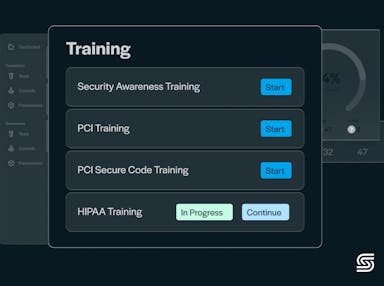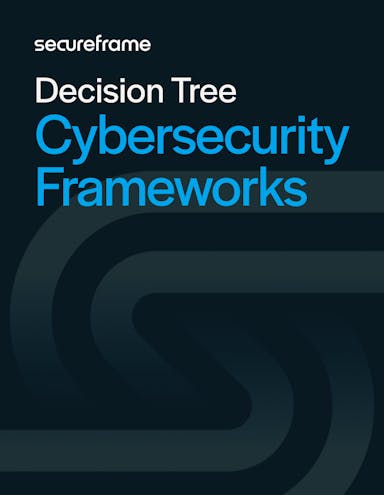
MSP Compliance: Common Frameworks, Challenges & Solutions Explained
Anna Fitzgerald
Senior Content Marketing Manager
Aaron Melear
VP of Partnerships and Alliances
As managed service providers (MSPs) take on increasingly critical roles in managing the IT systems and sensitive data of their clients, compliance with industry regulations and frameworks is essential.
Today, MSPs are not only tasked with helping their clients achieve and maintain compliance — they’re also expected to do so themselves to ensure they have appropriate security measures in place and build trust with their clients.
This guide outlines all the reasons why compliance matters for MSPs, the most relevant frameworks to MSPs and their clients, and how Secureframe can help simplify and speed up compliance.
Why is compliance important for MSPs?
In today's digital landscape, compliance isn't just a checkbox—it's a business imperative for MSPs. Let’s take a look at a few key reasons that compliance is important for MSPs:
- Avoiding penalties and fines: Depending on location, industry, and type of data you manage, there may be laws and regulations that apply to your MSP business. If you manage credit card information, website cookies, or personal identifying information, for example, there are regulations you must adhere to — or risk significant penalties and fines.
- Building trust and enhancing your reputation: Clients rely on MSPs to handle sensitive data and maintain security. Compliance not only demonstrates your commitment to these priorities — it also helps reduce the risk of data breaches that can significantly damage your reputation. Since repairing trust is painstaking work and is not guaranteed after a breach, compliance must be taken seriously to maintain the trust of your clients, partners, and other third parties.
- Mitigating risks: CIS Critical Security Controls®, SOC 2, ISO 27001, HIPAA, and other frameworks provide comprehensive guidelines for managing information security and privacy risks, from identifying potential threats to implementing effective controls. Adhering to these frameworks helps ensure MSPs are well-prepared to detect, respond to, and recover from security incidents, thereby minimizing potential disruptions and losses.
- Differentiating from non-compliant competitors: Demonstrating a commitment to security and compliance can set an MSP apart from its competitors. Many clients, particularly those in regulated industries such as finance and healthcare, prefer to work with MSPs who have achieved compliance with recognized standards.
Recommended reading

The Competitive Advantage of Compliance: 9 Reasons to Prioritize Data Security and Privacy
MSP compliance frameworks
The best compliance framework for an MSP depends on its target market, the type of data it handles, and client expectations. By aligning with the right framework, MSPs can meet regulatory requirements, build client trust, and secure new business opportunities.
Here are some key frameworks for MSPs, with an overview of each’s purpose, key benefits, and best fit.
CIS compliance for MSPs
The CIS Critical Security Controls® (CIS Controls®) are a set of 18 prioritized actions designed to mitigate the most common and severe cybersecurity threats. These controls serve as a blueprint for building a robust cybersecurity defense, helping MSPs secure their infrastructure and their clients' systems. As a result, CIS is the most commonly leveraged framework as a baseline for security within the MSP community.
Key benefits:
- Offers a cost-effective and scalable security framework
- Provides an actionable but flexible roadmap for reducing risks
- Enhances operational security for MSPs and clients
Best suited for: General use across industries, especially for MSPs working with small to medium-sized businesses (SMBs) or clients without specific regulatory requirements.
HIPAA compliance for MSPs
Health Insurance Portability and Accountability Act (HIPAA) ensures the confidentiality, integrity, and availability of Protected Health Information (PHI). MSPs managing healthcare data must implement strong access controls, encryption, employee training, and regular risk assessments to meet these stringent requirements.
Key benefits:
- Demonstrates commitment to protecting patient data.
- Builds trust with healthcare clients by ensuring their legal and ethical obligations are met.
- Mitigates risks of costly fines and breaches.
Best suited for: MSPs managing PHI and/or who have clients in the health care industry, including hospitals, clinics, dentists, health insurance providers, and healthcare clearing houses, among others.
SOC 2® compliance for MSPs
SOC 2® focuses on the security, availability, processing integrity, confidentiality, and privacy of customer data. During a SOC 2 audit, a CPA firm will assess how well an MSP protects customer data against applicable Trust Service Criteria (security, availability, processing integrity, confidentiality, and privacy).
Key benefits:
- Builds credibility with prospective clients by showcasing mature security practices.
- Supports business growth by meeting vendor requirements.
- Differentiates MSPs in a competitive market.
Best suited for: MSPs offering cloud or managed IT services or handling sensitive data in the cloud that need to prove to clients that they have the right controls in place.
ISO 27001 compliance for MSPs
ISO 27001 is an internationally recognized standard that provides a systematic approach to managing sensitive information through an Information Security Management System (ISMS). Certification proves an MSP’s commitment to continuous security improvements.
Key benefits:
- Establishes trust by demonstrating rigorous security standards.
- Streamlines partnerships with global clients.
- Promotes ongoing risk management and compliance.
Best suited for: MSPs working with enterprise clients or international companies that require compliance with global security standards and proof of commitment to continuous improvement in information security.
NIST 800-171 compliance for MSPs
NIST 800-171 focuses on safeguarding Controlled Unclassified Information (CUI) in nonfederal systems.
Key benefits:
- Enables participation in lucrative government contracts.
- Protects against threats to sensitive government data.
- Helps align with future compliance requirements, such as CMMC.
Best suited for: MSPs working with government contractors and subcontractors or handling federal data must comply with these standards to maintain contracts.
CMMC compliance for MSPs
The Cybersecurity Maturity Model Certification (CMMC) is designed to protect the defense industrial base (DIB) from cyber threats. It measures cybersecurity maturity across three levels.
Key benefits:
- Ensures eligibility for defense contracts.
- Demonstrates a proactive approach to cybersecurity.
- Provides a roadmap for continuous improvement in cyber resilience.
Best suited for: CMMC is mandatory for any MSP working with the Department of Defense (DoD) supply chain.
Recommended reading

CMMC vs NIST 800-171: Is CMMC 2.0 Replacing NIST?
Common compliance challenges for MSPs
Navigating compliance as a managed service provider comes with unique challenges due to the diversity of industries and clients you serve. Understanding these obstacles can help MSPs proactively address them.
1. Balancing compliance with daily operations
Operationalizing a security and compliance program often requires significant time and resources, which can divert attention from core operations. For smaller MSPs or those with lean teams, this balancing act can be particularly difficult.
Common struggles include:
- Resource allocation: Ensuring compliance while meeting client service-level agreements with limited resources.
- Limited bandwidth: Keeping up with audits, documentation, and training alongside day-to-day IT support.
How to address this: Automation and AI can help streamline time-consuming compliance tasks, like evidence collection and continuous monitoring, to give you time and resources back to ensure both compliance and operations run smoothly.
2. Keeping up with evolving regulations
The regulatory landscape is constantly changing, with new frameworks and updates to existing ones released regularly. This means MSPs and their customers must track changes across multiple frameworks like SOC 2, HIPAA, and ISO 27001 and adapt quickly to maintain compliance for themselves and their clients. If they can’t effectively manage regulatory changes, MSPs and their clients may face compliance violations, legal penalties, reputational damage, and operational disruptions.
How to address this: Partner with compliance experts or invest in compliance solutions that are updated as frameworks, such as PCI DSS 4.0, ISO 27001:2022, and NIST CSF 2.0, evolve over time. Ideally, do both so you can understand any regulatory changes affecting your businesses and maintain continuous compliance.
Recommended reading

A Guide to Regulatory Change Management & How Software Can Simplify It
3. Managing documentation and evidence
Compliance requires detailed documentation of policies, procedures, and technical controls, as well as evidence to prove they are in place and effective. MSPs often struggle with managing multiple documents across different frameworks and ensuring all required data is collected and organized in time for audits.
This manual work can also eat up valuable time and resources. According to a survey by Deloitte, companies spend an average of 2,000 hours per year on compliance activities, with documentation and reporting constituting about 20-30% of this effort. That’s 400 to 600 hours per year.
How to address this: Use a centralized platform to automate document management and evidence collection, ensuring nothing falls through the cracks and helping to boost efficiency.
4. Training and ensuring security awareness of employees
Employees play a critical role in achieving and maintaining compliance. Most security frameworks, including SOC 2, ISO 27001, HIPAA, and others, require security awareness training to be conducted regularly to ensure all employees are trained on security and privacy best practices related to their job and/or organization.
However, many MSPs face challenges such as:
- Making compliance a priority for teams who may see it as an administrative burden.
- Ensuring all staff understand their role in compliance efforts.
- Tracking that all employees completed training annually, especially as new talent joins.
- Unengaging and outdated compliance training.
How to address this: Emphasize how compliance supports overall security and business goals and implement regular, engaging training sessions. A compliance automation platform with built-in proprietary training can provide modern, engaging content so crucial information sticks long after the training and automate the assignment, tracking, and reporting of this training.
Recommended reading

Secureframe Training: Automatically Distribute, Remind, and Track Compliance Training for SOC 2, HIPAA, PCI DSS, and More
5. Ensuring client alignment
Since MSPs work with a variety of clients, each with unique compliance needs, aligning their services with every client’s requirements can be daunting. Challenges include:
- Understanding client frameworks: Due to the complexity and flux of compliance requirements, most clients can’t fully understand and implement necessary measures on their own and look to MSPs for technical expertise. This requires MSPs to know which frameworks (e.g., CMMC or SOC 2 or ISO 27001) apply to each client, what their purpose and ideal use cases are, and how they overlap.
- Customizing services: MSPs are challenged with tailoring IT solutions to meet specific client compliance needs without overextending resources.
How to address this: Standardize your approach to compliance while offering flexibility for client-specific requirements, and communicate your processes clearly during onboarding. A compliance automation platform can help you implement a framework that is prescriptive and flexible enough to support a client base and then adapt it to all of your clients.

Cybersecurity Frameworks Decision Tree
Use this series of questions to help select the best cybersecurity framework(s) based on your or your clients' industry, data, and needs.
6. Preparing for audits
Audits can be stressful and time-intensive, especially for MSPs who may need to prepare for their own as well as their clients’. As previously mentioned, compiling the necessary documentation and evidence is a major pain point. Discovering non-compliance issues right before or during the audit can also be a significant issue, causing MSPs to scramble to remediate the issues.
How to address this: Conduct internal compliance assessments regularly and invest in tools that offer audit readiness features, like checklists and mock assessments, and continuous monitoring to ensure you have peace of mind that you are audit-ready and maintaining compliance year round.
Recommended reading

Audit Management 101: How the Right Process and Tool Can Streamline Compliance
MSP compliance solutions
Compliance can be a daunting challenge for MSPs that don’t have the right tools and expertise.
Juggling multiple frameworks, managing diverse client needs, and keeping pace with evolving regulations require a strategic approach. MSP compliance solutions offer the tools and expertise needed to streamline these efforts, helping MSPs focus on their core services while maintaining trust and credibility with clients.
MSP compliance solutions are specialized tools, platforms, and services designed to help MSPs meet regulatory requirements efficiently. They combine automation, expertise, and resources to simplify the often-complex process of achieving and maintaining compliance with frameworks like HIPAA, SOC 2, ISO 27001, and more.
These solutions go beyond checklists—they provide end-to-end support for identifying gaps, implementing controls, and monitoring compliance over time.
Key features of MSP compliance solutions include:
- Automating compliance workflows: From policy creation to control monitoring, compliance solutions reduce the manual burden of compliance.
- Prescriptive guidance: Solutions often provide initial gap assessments to identify areas of non-compliance, paired with actionable recommendations for remediation.
- Framework mappings: Compliance solutions help MSPs align with multiple frameworks, mapping controls across HIPAA, SOC 2, ISO 27001, NIST 800-171, and more, reducing duplication of effort.
- Continuous monitoring and alerts: Compliance solutions continuously monitor and track system activity, flagging potential risks or non-compliance in real-time.
- Documentation and reporting: These solutions have centralized dashboards and automated reporting tools that make it easier to generate evidence for audits, satisfy client inquiries, and demonstrate compliance.
By automating routine tasks and centralizing compliance management, these solutions free up MSP teams to focus on their core offerings. They also unlock other benefits, helping MSPs to quickly adapt to new requirements and client expectations, proactively addressing vulnerabilities and issues, demonstrating a commitment to security and compliance, and enhancing client trust.
How Secureframe can help simplify MSP compliance
Secureframe is known for helping teams reduce time spent on manual compliance tasks by at least 26% per month, increasing security postures and speed to market. The platform allows partners and customers to efficiently implement, manage, and monitor critical security and compliance frameworks such as SOC 2, ISO 27001, NIST 800-171, and CIS.
Here are a few key ways Secureframe simplifies compliance for MSPs:
- Automated compliance for the most frameworks out-of-the-box: Secureframe automates evidence collection and other compliance workflows for the most security frameworks, including CIS Controls, SOC 2, ISO 27001, NIST 800-171, CIS Controls, and more than 30 others, ensuring MSPs can quickly and easily get and stay compliant with evolving requirements.
- Expert guidance: Secureframe customers can work with our in-house team of compliance managers to address complex requirements and get personalized advice based on their unique risks, industry requirements, and clients.
- In-platform training: Secureframe provides proprietary employee training that meets SOC 2, ISO 27001, HIPAA, NIST 800-171, CMMC, and other framework requirements including insider threat and role-based training. It is reviewed and updated annually by compliance experts.
- Policies developed by experts: Secureframe offers policies and procedure templates, developed and vetted by compliance experts for all out-of-the-box frameworks. You can easily publish this documentation, assign them to owners, and track policy acceptance and regular review within Secureframe.
- Control mapping: Secureframe automatically maps the controls you already have in place for one framework like SOC 2 to other in-demand frameworks like ISO 27001 to make it faster and easier to achieve compliance with multiple standards.
- Automated gap analysis: With over 220 deep integrations, you can pull in all the compliance data you need and get a constantly evolving and up-to-date gap analysis for each framework your organization is pursuing so you know exactly where your system falls short in protecting customer data and can create a remediation plan to bring them in line before an audit.
- AI innovations: Secureframe continues to lead in AI-driven compliance innovation. You can use AI to automate the process of remediating failing controls, completing risk assessments, creating and editing policies, and more, further simplifying the path to audits and continuous compliance.
- Audit readiness dashboard: Secureframe’s centralized dashboard provides real-time insights into compliance status, helping MSPs quickly identify and address potential gaps across multiple frameworks so they have peace of mind going into an audit.
- Continuous monitoring: Secureframe continuously monitors your security controls, automatically identifying compliance gaps, misconfigurations, and failing controls. This enables you to maintain a strong security posture and continuous compliance without the need for constant manual checks.
By aligning with relevant compliance frameworks, MSPs can build trust, mitigate risks, and stand out in a competitive market. To help MSPs unlock these benefits faster, we offer unique benefits through the Secureframe Service Partner Program, including:
- Cost savings: With our Not-For-Resale (NFR) offering, Service Partners can utilize Secureframe's cutting-edge compliance software within their own operations, specifically tailored to the CIS framework, for free. If Service Partners want to expand beyond this free limited internal use, we offer heavily discounted use of our software.
- Free Trust Center: MSPs can showcase their security and compliance posture in real-time to establish transparency and trust and differentiate themselves from competitors through Secureframe’s Trust Center, which is complimentary for Secureframe Service Partners.
Ready to take the next step? Request a demo to see how Secureframe is here to guide you every step of the way.
Use trust to accelerate growth
FAQs
What’s the difference between SOC 2 and ISO 27001 compliance for MSPs?
SOC 2 and ISO 27001 are two of the most rigorous security and compliance standards designed to demonstrate to clients that you can be trusted with their data. SOC 2 tends to be more commonly requested by clients in the US, while ISO 27001 tends to be more commonly requested by international customers. The most important factor for MSPs deciding between SOC 2 and ISO 27001 will come down to what their target market expects and requires.
How can an MSP determine which compliance frameworks to follow?
The choice depends on your client base, industries served, and data managed. For example, MSPs that manage PHI should prioritize HIPAA, while those working with government contractors should focus on NIST 800-171 and/or CMMC.
How long does it take to achieve compliance for MSPs?
The timeline varies depending on the framework and the MSP's existing security measures. Partnering with solutions like Secureframe can significantly shorten the process, no matter what framework the MSP is pursuing or cyber maturity they’re starting with.

Anna Fitzgerald
Senior Content Marketing Manager
Anna Fitzgerald is a digital and product marketing professional with nearly a decade of experience delivering high-quality content across highly regulated and technical industries, including healthcare, web development, and cybersecurity compliance. At Secureframe, she specializes in translating complex regulatory frameworks—such as CMMC, FedRAMP, NIST, and SOC 2—into practical resources that help organizations of all sizes and maturity levels meet evolving compliance requirements and improve their overall risk management strategy.

Aaron Melear
VP of Partnerships and Alliances
Aaron Melear served as Vice President of Partnerships and Alliances at Secureframe, where he built and scaled the company’s global partner ecosystem. With over a decade of experience leading channel and alliance programs at top cybersecurity organizations—including Duo Security and Vanta—Aaron is passionate about helping partners accelerate revenue growth through automation, collaboration, and trust. During his tenure, he focused on empowering MSPs, auditors, and consulting partners to deliver faster, smarter compliance outcomes for their clients using Secureframe’s platform.